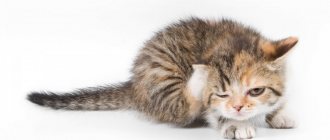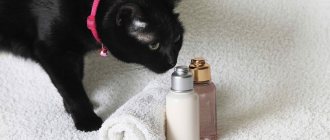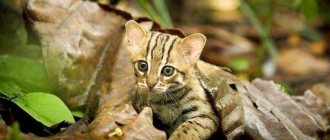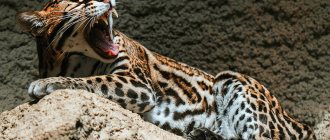Pets are not toys, but full-fledged members of the family. When choosing a pet, it is important to consider whether it will be comfortable living with you. Not all “mustaches” are patient with children’s pranks and can easily hit back with a clawed paw. Representatives who are too timid may suffer themselves: both physically and psychologically.
Below you can find out what criteria you should pay attention to first, and also get acquainted with the best cat breeds for children of different ages.
What breed of cats should you choose for children?
Choosing a cat for children is not an easy task. Ideally it should meet the following criteria:
- Goodwill.
Avoid overly capricious and aggressive representatives who lack patience.
- Good health.
Don't get a cat that has musculoskeletal problems.
- Stable psyche.
When meeting, evaluate the kitten’s reaction to noise and sharp sounds. If the clap of your hands immediately sends him into a corner, look for a bolder candidate.
- Hypoallergenic.
In addition to the length and thickness of the coat, it is important to consider the amount of specific protein - the main cause of an allergic reaction to animals.
- Weak shedding.
The absence of thick undercoat and long hair will not only reduce the likelihood of allergies, but will also simplify caring for the animal.
- Talkativeness.
It can be both a plus and a minus. Talkative breeds are not suitable for families with babies, but for older children such cats can be a pleasant bonus.
- Activity level.
Aim for medium or high. Excessive passivity is fraught with the emergence of hostility.
Having a pet is a unique opportunity to instill in a child a sense of responsibility and eradicate existing communication problems. Don’t try to take on all the care yourself - be sure to involve the new owner in this important matter, not forgetting about support at the initial stage.
Siberian
It acquired its current appearance in Russia. It also came to Western Europe in the 80s of the 20th century. In 1998, the International Cat Federation recognized Siberian cats as a separate breed.
Children love them and can play and tinker with them for hours. At the same time, the cat never becomes aggressive and is especially attentive to small children.
Thus, the Siberian cat is a true family cat that gets along well with everyone. However, she usually has a loved one who loves her especially. Despite all the affection, the Siberian cat, like all representatives of natural breeds, is an excellent hunter with a great impulse to move.
The Siberian cat has semi-long, silky hair that comes in different colors and a fluffy tail. The body is quite large and muscular. Females weigh on average 4.5 kg, males 6 kg. The eyes are slightly slanted and come in a variety of colors, especially bright blue. Caring for a Siberian cat is similar to caring for a domestic cat. The Siberian cat needs a lot of exercise and affection.
The kindest cat breeds for families with children
First of all, let's look at cats that not only love children, but are also among the most good-natured. Such pets are famous for their friendliness and complete lack of aggression towards everyone without exception.
Ragdoll
At first meeting, the Ragdoll seems extremely lazy and phlegmatic. The thing is that he is selflessly devoted to his master. Next to him, the cat feels completely protected and does not see the need to take a defensive position.
INTERESTING!
At birth, the Ragdoll's coat is completely white. She acquires the color typical for the breed only by 2-3 years.
Thanks to the peaceful nature of the Ragdoll, it is impossible to get angry. Kids can easily dress him up in dresses and other clothes, as well as carry him in a stroller and have lengthy photo sessions.
More about
ragdoll
Ragamuffin
This fluffy beauty is a close relative of the ragdoll, so you shouldn’t be surprised at the similarity of their characters. Both heavyweights are unusually kind and affectionate creatures who love to perch on the hands or knees of their owners.
When keeping a ragamuffin, it is important not to forget about its vulnerability and complete lack of protective instinct. He is simply not able to fight back, so he can easily suffer from careless or downright cruel treatment. For this reason, it is not recommended to let him go outside unattended.
More about
ragamuffin
Exotic
Unlike Persian cats, exotic cats are more docile and playful. They sincerely become attached to their owners and show their feelings delicately.
Aggression on the part of “exotics” is only possible towards strangers. When surrounded by family, these “mustaches” quite calmly accept hugs and affection, and also take part in children’s fun with great pleasure.
More about
exotic
Scottish
The friendliness of these cats does not depend on the shape of their ears. Both Scottish Straights and Scottish Folds get along well with the younger generation without any problems. They also easily find a common language with birds and rodents.
“Scots” cannot stand prolonged loneliness, therefore, the more people are at home, the better their well-being. The peak activity of these “mustaches” occurs in the first year of life, but some retain their childish restlessness until old age.
Read more about the Scottish
Fold and Straight Ear
American Curl
The American Curl is an ideal companion cat, completely devoid of aggression and typical feline independence. He loves the owner by default and prefers to spend his leisure time exclusively in his company.
Thanks to its balanced character, the American Curl is non-conflict and unusually patient. He uses his claws exclusively for the purpose of hunting. This cat also quickly adapts to new conditions and perceives loud sounds completely calmly.
More about
American Curl
Peterbald (Petersburg Sphynx)
Although hairless cats were bred primarily through Sphynx cats, they remain a very popular sight. However, they can be a boon for allergy sufferers. The Peterbald, like other representatives of this category, is a wonderful, sweet cat.
Peterbald owes its name to the Russian city of St. Petersburg. There he was first bred in 1994 from a pair of Don Sphynx and Oriental Shorthair.
Like its close relatives, the Peterbald is very attached to people. He prefers to cuddle and play with his loved one. He is also very open towards all residents in the house, including other pets, which he treats with great tolerance.
Peterbald especially appreciates children because they are as playful as he is. The Peterbald has no fur, only a little fluff. This is their most noticeable feature. The cat itself is slender and muscular, and can weigh up to 4 kg. The Peterbald does not require any grooming, but the skin must be protected from cold and sunlight.
Which cat breed is best for preschool children?
It is quite difficult to explain to preschoolers how to properly behave with animals. For such children, it is better not to take kittens, but if you really want to, then make sure that you can definitely control the communication process.
The animals from this collection are not just kind, but very reserved. If the baby gets naughty, the cats will simply proudly walk away in an unknown direction and will not teach him good manners with the help of sharp claws.
Russian blue
Russian Blue is a typical mannered aristocrat. She is not capricious and never stoops to deliberate sabotage. When communicating with household members, this cat is sweet and spontaneous, but can hide under the bed when strangers appear in the house.
The Russian Blue is lenient towards children's pranks. She never loses her composure and does not get involved in conflicts. If the little owner allowed himself too much, the cat will silently leave him alone.
More about Russian Blue
Nibelung
The Nibelung is another furry gentleman with a phlegmatic personality. Like the Russian Blue, he never stoops to fights and tries to resolve any conflicts peacefully.
The only drawback of the Nibelung is its intolerance to loud and harsh sounds. In a family with a newborn baby, he will feel uncomfortable.
More about
the Nibelung
Neva Masquerade
The Neva Masquerade is also notable for its innate nobility. She has no problem allowing familiarity with the little ones, but only if there are family ties. This cat will not tolerate hugs from strangers.
The Neva Masquerade is an excellent hunter. Living outside the city, she never loses sight of mice, moles and other pests.
More about
the Neva Masquerade
Maine Coon
The Maine Coon is the largest representative among the furry goodies. Despite its innate independence, this cat is quite supportive of tactile contact.
INTERESTING!
Maine Coons have the longest tails. The size of their furry property is often equal to the length of the entire body.
The main disadvantage of the Maine Coon is its size. If he plays too much, he can injure even an adult, so you should not leave your child alone with him.
More about
Maine Coon
American Shorthair
The calm and friendly American Shorthair is tolerant of children's pranks and never lets out its claws when playing together. Tired of attention, the mustachioed pet simply hides somewhere on a hill.
Like the Neva Masquerade, the American Shorthair has a developed hunting instinct. For this reason, it is not recommended to keep it in the same house with birds and rodents.
More about
the American Shorthair
Abyssinian
The Abyssinian's roots are in Southeast Asia, and they are one of the most bred cat breeds in the world. It came to Europe in the 19th century and was registered in Germany in 1933. Like many other cat breeds, the Abyssinian's survival was threatened during and after the two world wars.
No matter how many animals live in a farm that provides entertainment, the Abyssinian is very human-oriented. The Abyssinian cat looks at people with curiosity, and especially at children. A smart kitten carefully records every action. Cats love children very much, and boredom and excessive rest are out of the question.
The Abyssinian is slender and finely built, with long legs. Reaches a shoulder height of 40 and a length of 60 cm. Cats weigh from 2.5 to 4 kg, males - from 3.5 to 5 kg. The coat is short and has no pattern in purebred Abyssinians.
The short coat of the Abyssinian does not require special care. It should be brushed from time to time; cats shed in the spring. She needs a lot of attention, movement and variety.
Active cat breeds for adult children
Kittens for older children can be more independent and playful. Schoolchildren perceive prohibitions more easily and are able to restrain emotions when communicating with a furry friend. They are also much more careful, so they are unlikely to step on the pet’s paw or tail while playing together. For this reason, the best choice in this situation is active breeds that are famous for their friendliness.
Oriental
Despite their origin, Oriental cats are completely devoid of Asian mentality. They are sociable, playful and madly in love with their owner.
INTERESTING!
“Orientals” love to copy human behavior. Because of this, it is easier to train them to use the toilet rather than the litter box.
The behavior of “orientals” is close to that of a dog. Representatives of the breed are highly dependent on human attention and respond well to training. Mustaches have a special passion for fetching objects.
More about
orientals
Burmanskaya
The Burma remains active until old age and greatly values physical contact with its owner. She will always prefer human laps to a cozy chair.
Thanks to its playful nature, the Burma easily fits into any children's company. She calmly accepts not only overly strong hugs, but also random pokes.
More about
Burmese
Burmese
Smart and savvy "Burma" is somewhere in the middle. She cannot be called passive, but she is far from a playful “oriental”. Despite this, she enjoys playing with the little ones and knows how to “control herself” (that is, in her paws) even in the heat of excitement.
"Burma" does not tolerate loneliness and always strives to be in company. Thanks to this quality, she easily finds common contact not only with people, but also with other pets, including dogs.
More about
Burma
Manx
Unlike the Ragdoll and Ragamuffin, the Manx is able to stand up for both itself and its territory. He has a developed hunting instinct and is not at all afraid of water, which allows him to successfully catch not only birds, but also fish.
Manx treats household members as peacefully as possible. This energetic cat shows a special love for outdoor games: fetching a ball and catching a laser beam.
Pixiebob
Despite its wild appearance, the pixie bob is a patient and delicate pet. He is always ready for active games, but never imposes his communication if the owner is busy or simply out of sorts.
INTERESTING!
Pixiebobs often have polydactyly, or multiple toes. Thanks to the extra finger, these animals can squeeze a wide variety of objects in their paws, just like a human.
The pixie-bob immediately stops suffocating hugs and tail tugging. Familiarity is unacceptable for him, so communication with children is possible only under the condition of mutual respect and understanding of personal boundaries.
Turkish Angora
The noble Angora celebrated success as one of the oldest cat breeds of the Ottoman Empire. It was recognized as a breed back in the 15th century. Angora" is the old name of Ankara. For a long time, the Angora cat was understood as all cats with long hair, mostly white. The term is still used today outside of specialist circles and is sometimes used colloquially as a synonym for Turkish Angora.
This breed arose without human intervention. She is distinguished by her special loyalty, which is often compared to dogs. Because she follows her guardian every step of the way. Most of the time she hopes to be petted, as she needs a lot of love and pleasant sensations. The Turkish Angora is usually an easy-going personality that gets along well with everyone: with its relatives and other pets such as dogs, and, of course, with its owners.
This breed is an excellent playmate for children. Because their joy from playing practically knows no bounds and hardly diminishes with age. The cat also likes to fetch smaller toys, which regularly excites children. She attracts attention by purring and stroking her legs. If a cat feels neglected, it may become withdrawn. In addition to careful care, she also needs a lot of space to be able to live to her satisfaction. The cat has semi-long, silky fur that fits tightly to the body because it has no undercoat. The colors are white, black and red with different shades. The body is long and slender, at the same time muscular, although the cat looks fragile. Even male cats hardly exceed 4 kg.
Hypoallergenic and non-shedding cat breeds for children
The latest selection includes those who shed lightly and rarely cause allergies. Parents of children with frequent allergic reactions should pay attention to such “mustaches.”
Sphinxes
Canadian, Don and St. Petersburg Sphynxes are the most recognizable hairless cats with a canine character. Due to the lack of hair, they are often acquired by allergy sufferers, but it is important to understand that the allergen is usually not the hairs themselves, but the protein found on them. To avoid an allergic reaction, it is recommended to wash Sphynx cats once every 1-2 weeks.
All pets from this group are unusually gentle and vulnerable pets. They have a dire need for communication and can be intrusive when expressing their feelings.
More information about
the Don , Canadian and St. Petersburg sphinxes
Rex
In this case, low shedding and hypoallergenicity are explained by the lack of undercoat. All representatives are united by unusual curly fur and amazing energy.
Like hairless sphinxes, rexes are vulnerable to low temperatures. They cannot be kept in the cold, so in late autumn and winter it is recommended to dress them in sweaters and other warm clothes.
Read more about the
Cornish , Devon and Selkirk
Elf
This funny hairless cat with curled ears is the result of crossing a Canadian Sphynx and an American Curl. He does not tolerate loneliness well and easily makes friends among other animals.
INTERESTING!
Elves are prone to gluttony and are very curious. Unlike other mustaches, they try new foods with great enthusiasm and practically do not chew their food.
The body of elves abundantly secretes fatty lubricant. Without regular water procedures, it begins to smell unpleasant and leave marks on clothes and furniture.
Ukrainian Levkoy
The shape of this cat's ears is explained by its close relationship with the Scottish Fold. The Ukrainian Levkoy is notable for its innate intelligence and delicacy. He easily learns basic commands and tricks, and also quickly makes friends with his little owners.
Cultured and reserved Levkoys have a hard time withstanding criticism and punishment, so when raising them it is recommended to use only support and praise. Don’t forget about the importance of verbal communication. Ukrainian Levkoys love to chat, but rarely speak first, as they try to avoid being overly intrusive.
Napoleon
Napoleon is the result of crossing a Munchkin and a Persian. The cat inherited short legs from the first parent, and a flat muzzle from the second. Despite the strong fluffiness, he practically does not shed.
Napoleon adores human company and is almost completely devoid of aggression. His gentle character allows him to stoically endure children's pranks, and his love for physical contact allows him to endure even the strongest and most clumsy hugs.
The nature
The breed of a cat does not guarantee that the pet will have the desired character traits. However, cases of “undesirable” nature in purebred cats are an exception to the rule.
Sociable and talkative
Communicating with your cat is a pleasant activity that talkative pets will happily share with their owner. If you want to discuss the weather with your cat every day, the following breeds are suitable:
A purr that's fun to talk to
Kitchen Talk Lover
Warm and smooth myavlik
Fan of philosophical conversations
Accompanies every action with his “meow”
Thai cat
Loves to talk even to herself
Sociable cat breeds enjoy philosophical conversations with their owners. Do not choose this breed if you value silence in your home.
Meowing can also irritate a cat's owner. If you prefer not to hear unnecessary sounds, choose from these breeds:
A cat who is too lazy to meow
Able to communicate with the owner without making sounds
Northern wisdom and silence
Doesn't meow while being fed
Turkish Angora
The Snow Queen
Exotic cat
Doesn't waste energy talking
Silent cats won't bother you and you'll keep your home calm
Representatives of these breeds will only meow for important reasons.
Active and energetic
It’s interesting to watch active cats: today the pet wanted to explore the closet, and tomorrow he will become an astronaut! These are the cats that love activity:
Astronaut cat with fiery color
Curious entertainer
Energetic and smart
Jumper with a short tail
Comes up with problems and solves them
Turkish van
Lover of games and swimming
Owners of energetic cat breeds will have to constantly come up with something to keep their pet occupied. But it's worth it! They will be happy to solve your puzzles and wait for the next ones.
Lazy cats
There are cats that don't like to run around their owners' shelves. You can eat well and then sleep well! The following breeds are true sloths:
Loves to eat and sleep
A cat who is interested in lying with his owner
Real cat pillow
Always resting to be ready for the hunt
Moves only to find a comfortable position
Exotic cat
Sloth cat with a cute face
Lazy cat breeds are a good choice for phlegmatic people. Slothful cats can be so inconspicuous that only a regularly empty bowl hints at the existence of a cat in the house.
Affectionate and kind
People get cats to pet them and love them! Affectionate breeds themselves come to hug and kiss, so they are suitable for loving owners:
They follow their owner like a tail
A cat who will live on your shoulder
Ball with love for affection
Will be happy to come pet you
Always remain affectionate kittens
Ragdoll
Tame cat with a submissive character
Such breeds are reluctant to get off their owner: they don’t like to part with their beloved friend! Choose an affectionate cat breed if you are willing to give it enough attention.
Smart cat breeds
It is interesting to communicate with intelligent pets: they understand speech, easily learn commands and become a true friend. Smart cat breeds include:
Easy to learn commands and rules
Trainable and intelligent cat
High intelligence and innovative thinking
A lively mind and good learning ability
A cat that acts like a dog
Turkish Angora
Know the wisdom of human life
Such cats can be trained: they learn to fetch a ball, perform actions, dance and walk on a leash. Cats with high intelligence are the choice of people who do not want to get a dog.
What breeds should you avoid?
Despite the large number of options, there are also those that are recommended to be avoided. The worst options include the following breeds:
- Siamese;
- British;
- Persian;
- Abyssinian;
- Mekong Bobtail;
- ocicat;
- all hybrids (savannah, chausie, bengal, etc.).
The listed animals are united by a developed territorial instinct, monogamousness and a tendency to defend themselves with bites. Because of these qualities, they are often called evil, but in fact, even such pets can be unusually gentle and kind. You can win their love through mutual respect for interests and respect for personal boundaries.
Read about
cat breeds that are considered the most evil
British Shorthair
The British Shorthair originated quite accidentally in 19th century Britain from domestic cats that once arrived on the island with the Romans, and various breeds. The thick fur looks like plush.
The British Shorthair cat is very fixated on people and absolutely demands attention - anywhere and at any time. The shy cat usually gets along well with other animals, especially if they have been socialized from an early age. Despite all its coziness, the powerfully built British Shorthair is also a good hunter who persistently pursues its prey.
The cat is stocky - this is due to thick hair, on the one hand, and a strong physique, on the other. Females weigh from 4 to 6 kg, males - from 7 to 8. Fur colors are very varied, but the ash color is especially popular among breeders and owners.
Which kitten should you not choose if there is a child in the house?
When considering how to choose a cat, you need to familiarize yourself with the breeds that are unacceptable for keeping in an apartment where there is a small child. These are Siamese cats with a quarrelsome disposition.
If there is a newborn in the house, then the choice of cat should be approached intelligently
In addition, keeping American Curls, British and Scottish Folds with children is unacceptable - the child may accidentally injure the animal. You should not have munchkins - these cats with short legs are very sensitive to accidental falls. We need to choose a breed with stronger bones.
Note! It is not recommended to have an unneutered cat of any breed.











